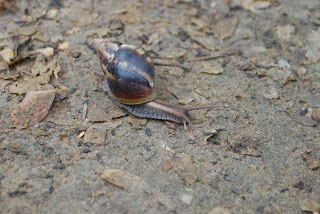Without further ado, I present la famille TSIVANYO.
The day CHAP Trainees were paired up with Togolese families in Gbatopé is one I’ll never forget. Parents and children, dressed up in their finest pagne complets, sang and clapped their hands to the music as they awaited the arrival of 13 PC Trainees. We were all so nervous and scared, yet fired up to see our new families. Administration pressed formal attire for our welcoming, so I chose my purple silk dress from Shanghai. This was first-rate dress because I happened to match my host mom’s ensemble. Other families were overjoyed to witness the cute combo.
Without hesitation, my house was very much comparable to a summer cabin found in the upper lower peninsula of Michigan. It was a small, yellow house hidden by bushes with hundreds of red-orange flowers. The house didn’t have running water, so my host brother, Fogant, fetched water from a nearby pump. Or since it was rainy season, we relied heavily on rainwater—two long gutters that channeled water into three concrete holes. I didn’t have electricity, but my family had cut off a foot long section from a bamboo tree, packed four large batteries inside with rocks holding wires in place, and then connected the wires to what looked like old Christmas lights. Boom. This set up, though brilliant, didn’t work until a week before I left Gbatopé. Better late than never!
The family, même:
My Mom, Mamasan, was lovely woman—a street seller of manioc and tapioca. She was married twice—quite a knockout—and has eight children. She was a phenomenal cook, even though my stomach was intolerable.

My sister, Ademe, was cute but very quite. I think what I liked most about her were her kids: two twin girls and a boy. I nicknamed the twins La Folle and La Grande (Crazy and Big). The boy was the oldest, but such a crier!! He never got habituéd to the yovo in the house, screamed bloody murder whenever I walked up to him. I did this a lot. Hehehe.

My brother, Fogant, was nice though a bit strange. He was incredibly helpful and carried my heavy bags and packages on top of his head numerous times. In the end, I chalked up my irritation to his incessant repetition of “il faut,” meaning “it is necessary.” The number of times he said “il faut” exceeded that of my fingers and toes over a three-day period.
One thing I’ll never forget:
The daily trips to my latrine. The distance from my bedroom to the latrine was approximately 40 feet, plenty of time for a mini conversation with my mom. My post-wakeup walk to the latrine convo usually went something like this:
Me: Bonjour Mamasan! Ça va?
Mom: Bonjour Sam! Oui, ça vas très bien? Tu as bien dormi?
Me: Oui, j’ai bien dormi. Merci. Et toi?
Mom: Oui, bien-sûr! Tu te sens bien? (Are you feeling well?)
Me: Oui, merci. (In my head: I just have to go to the bathroom, Mom!!)
Every time I needed to go to the bathroom, some variation of this conversation took place—with the exception of replacing bonjour with bonsoir depending on the time of day.
What else?
When I had giardiasis, one night I told Mamasan I needed to consume a lot of food for dinner with four tablets of Fasigyne 500. So what did Mamasan make? Roughly four servings of spaghetti with tomato sauce, a plate full of pineapples and bread! Wow. And I ate almost everything. Of course, I could barely breathe and slept on my back all night because I was so full. Nonetheless, she did well. Merci Mamasan.
Overall, I had a good experience with the Tsivanyo family. I plan to visit Mamasan soon, or at least the next time I travel south.
















